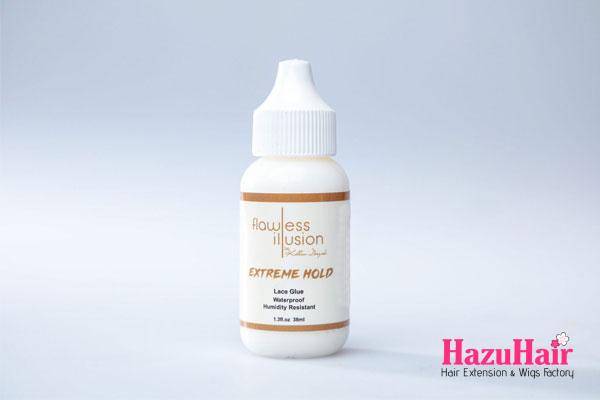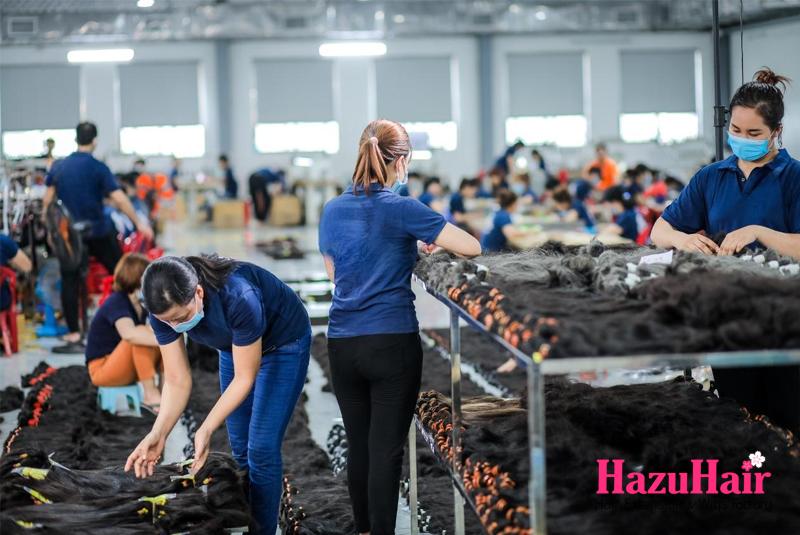Hair knowledge
Common Mistakes to Avoid When Using Lace Glue
Lace wigs are a fantastic way to achieve a natural, seamless appearance, allowing you to transform your look effortlessly. They provide versatility, confidence, and protection for your natural hair, ensuring it stays healthy and well-nourished beneath the unit.
However, certain mistakes and challenges can prevent you from achieving that perfect, undetectable installation. From improper application techniques to choosing the wrong lace glue, small errors can make a big difference in how natural your wig looks and how long it lasts.
A well-secured wig starts with high-quality lace glue, ensuring your edges remain protected, healthy, and intact.
In this article, we will explore the most common installation mistakes, the challenges people face, and expert tips to avoid them, so you can master the art of flawless lace wig application with confidence!

>>>Techniques and Methods to Co-Wash Your Hair Extensions
Common Mistakes to Avoid When Using Lace Glue for Wig Installation
Achieving a flawless, natural-looking lace wig installation requires careful preparation and the right techniques. However, many people unknowingly make mistakes that can compromise the hold, comfort, and overall appearance of their lace wig. Below are some of the most common mistakes and how to avoid them for the best results.
Skipping the Patch Test
A patch test is an essential step that should never be overlooked before applying lace glue to your scalp. This simple test helps identify any potential allergic reactions or skin sensitivities that could lead to discomfort or irritation.
To perform a patch test, apply a small amount of lace glue to a discreet area of your skin, such as your forearm or behind your ear. Allow the glue to sit for at least 24 hours, monitoring for any signs of irritation, redness, itching, or swelling.
If no adverse reactions occur, the glue is safe to use. However, if you experience any discomfort, discontinue use immediately and seek an alternative adhesive that is hypoallergenic or formulated for sensitive skin. Ignoring this step can result in severe allergic reactions, which may lead to scalp irritation, breakouts, or even hair loss.
Neglecting Proper Scalp Preparation and Protection
A well-prepared scalp is the foundation of a long-lasting and secure lace wig installation. Failing to cleanse and care for your scalp properly can lead to an uneven application, poor adhesion, and a shorter lifespan for your lace wig.
Start by washing your scalp with a gentle, oil-free cleanser to remove any dirt, excess oils, or leftover adhesive from previous applications. Exfoliating the scalp can also help remove dead skin cells that might interfere with adhesion.
After cleansing, apply a lightweight scalp moisturizer to keep your skin hydrated without making it too greasy. Using a scalp protective barrier is also highly recommended, as it creates a protective layer between the adhesive and your skin, minimizing irritation and preserving your natural hairline.
Neglecting this step can cause lace glue to clog hair follicles, leading to breakouts, scalp irritation, or even hair thinning around the edges. Additionally, an unclean scalp can compromise the longevity of your wig, causing it to lift prematurely.
Choosing the Wrong Type of Lace Glue
Not all lace glues are created equal, and using the wrong one can lead to a weak hold, skin irritation, or even damage to your lace wig. When selecting a lace glue, consider your scalp type, skin sensitivity, and lifestyle needs.
For example, if you have oily skin, opt for a waterproof, sweat-resistant formula that offers a strong hold even in humid conditions. If you have sensitive skin, look for an adhesive with a gentle, non-toxic formula to prevent irritation.
Additionally, different lace glues are designed for different durations of wear. Some provide a temporary hold for daily use, while others offer a longer-lasting bond for extended wear. Understanding these differences is crucial to ensuring a secure and comfortable fit for your lace wig.
Always invest in high-quality lace glue from reputable brands to ensure safety, durability, and a natural-looking finish. Cheap, low-quality adhesives may contain harmful chemicals that can cause skin damage or weaken the lace on your wig over time.

>>>Six Reasons Why I Love Wearing Hair Extensions
Using Too Much or Too Little Lace Glue
Applying the right amount of lace glue is key to achieving a secure, natural-looking wig installation. Both overusing and underusing lace glue can create problems that impact the wig’s longevity, comfort, and appearance.
- Applying Too Much Lace Glue: Using an excessive amount of glue may seem like a way to ensure a strong hold, but it often leads to messy results. Too much adhesive can create thick, sticky buildups along the hairline, making it difficult to clean and reapply the wig in the future. Overuse of glue can also seep through the lace, making it visible and reducing the overall natural effect. Furthermore, excessive glue can cause discomfort, as it can harden and feel heavy on the scalp.
- Applying Too Little Lace Glue: On the other hand, not using enough glue can lead to an insecure hold. If there isn’t enough adhesive to bond the lace to your skin properly, the wig may start lifting, shifting, or even slipping off throughout the day. This can be especially frustrating during activities that involve movement, such as exercising or being outdoors in windy conditions.
How to Apply Lace Glue Correctly
To ensure an even and secure application:
- Always start with a small amount of lace glue, working in sections rather than applying all at once.
- Apply the glue in thin, even layers, allowing each layer to become tacky before adding more.
- Begin from the center of your forehead, pressing down the lace as you go. This prevents air bubbles and ensures a smooth finish.
- Remember: With lace glue, less is more. It’s better to build up in layers rather than apply too much at once.
Wrongly Application Techniques
Even with the right amount of glue, improper application techniques can compromise your wig’s hold and overall look. Using the correct tools and methods is essential for achieving a seamless, long-lasting bond.
- Avoid Rushing the Process: Gluing down a lace wig is one of the most critical steps in the installation process. It requires patience and precision. Rushing through it can cause uneven placement, gaps in adhesion, and an unnatural appearance. Take your time to carefully position the lace before pressing it down firmly.
- Never Pull or Tug on the Wig: Many people make the mistake of pulling the wig tightly while trying to secure it. This can cause stress on both the lace and the adhesive, leading to premature lifting and weakening the glue’s bond. Instead, gently adjust the lace into place before pressing it down to ensure a snug, natural fit.
- Work in Sections for Better Control: When installing a lace wig, it’s best to work in sections rather than trying to secure the entire lace at once. Apply glue to one area at a time, wait for it to turn tacky, and then carefully press the lace down. This method allows for better control and a neater application.
- Be Careful When Adjusting the Lace: Once the glue has set, repositioning the lace becomes difficult. If you need to make adjustments, do so while the glue is still slightly tacky rather than fully dried. This ensures a smooth application without ruining the bond.

>>>All About Weave 101: The Ultimate Weave Glossary
Not Allowing the Lace Glue to Become Tacky Before Application
One of the most critical steps in melting your lace and achieving a flawless wig installation is ensuring that the lace glue has reached the right level of tackiness before attaching the wig. Rushing this step can result in weak bonds, wig slippage, or even complete detachment.
- Why is tackiness important?
When lace glue reaches the right level of tackiness, it creates a strong bond between the wig and the scalp, ensuring that the lace melts seamlessly into the skin. If the glue is still too wet, the wig won’t adhere properly, causing instability and potential lifting throughout the day.
- How to ensure the glue is tacky enough?
- Always follow the manufacturer’s instructions regarding drying time.
- After applying a thin layer of glue, wait until it becomes clear and slightly sticky before pressing the lace down.
- If needed, apply multiple thin layers, allowing each layer to dry until tacky before adding another.
- Using a blow dryer on a low, cool setting can help speed up the drying process without compromising the glue’s effectiveness.
- Use a melt belt or elastic band after securing the lace to further press it into the glue for a natural finish.
- Cutting the lace properly: If you’re unsure how to cut the lace correctly, it’s best to consult a professional. Poor lace cutting can make even the best installations look unnatural.
Using Low-Quality or Expired Lace Glue
The quality of your lace glue plays a significant role in determining how well your wig stays in place. Using a subpar or expired adhesive can result in weak hold, potential scalp irritation, and damage to your wig.
- The dangers of expired lace glue. Lace glue contains active ingredients that break down over time, causing it to lose its effectiveness. Expired glue may:
- Weaken the hold, making your wig more prone to lifting.
- Change in consistency, becoming too runny or clumpy.
- Lose its waterproof or sweat-resistant properties.
- Cause scalp irritation or allergic reactions due to chemical degradation.
- How to check if your lace glue is still good?
- Always check the expiration date before purchasing or using lace glue.
- Store glue in a cool, dry place away from direct sunlight to prevent it from degrading faster.
- If your glue has changed in texture, smell, or consistency, it’s best to replace it immediately.
- Why invest in high-quality lace glue?
Choosing a waterproof, long-lasting, and skin-friendly lace glue ensures a reliable and comfortable hold. A high-quality product prevents lifting, keeps edges intact, and contributes to a more natural look.
Poor Wig Removal and Maintenance
Taking care of your lace wig is just as important as installing it correctly. Improper removal and maintenance can weaken the lace, cause hair loss along the edges, and reduce the lifespan of your wig.
- The importance of a proper cleaning routine. Over time, oil, dirt, and adhesive residue build up on both your scalp and the wig. If not cleaned properly, these residues can weaken the bond of your lace glue, leading to frequent lifting and reapplications.
- Wash your wig regularly using a gentle, sulfate-free shampoo to keep it clean and fresh.
- Avoid heavy oils and greasy products that can interfere with adhesion.
- Clean your scalp before each installation to remove any dirt or leftover glue.
- How to remove a lace wig safely
- Never pull or rip the lace off this can lead to hair loss and damage the lace.
- Use a professional lace glue remover or alcohol-based solution to gently break down the adhesive before lifting the wig.
- Start by loosening the lace from the back and slowly work towards the front to avoid tension on the hairline.
- Be patient rushing this process can cause friction burns or irritation on your scalp.
- Why proper removal matters. Incorrect removal techniques can:
- Cause excessive shedding along the lace front.
- Lead to irritation or breakouts on the scalp due to glue buildup.
- Damage the lace, reducing the lifespan of your wig.

>>>How To Exercise While Wearing Hair Extensions
Lace Glue – The Ultimate Choice!
Lace glue is the go-to solution for a secure, comfortable wig installation. However, to achieve the best results, you must be extra careful during application. Even small mistakes can lead to hair damage and breakage along your edges.
Prioritizing comfort and convenience is key to ensuring a flawless, natural look. Choose a lace glue that suits your scalp, provides a strong hold, and meets your specific needs.
Now that you know what to avoid for a perfect, melt-proof finish, practice is essential. Mastering the application process takes time, and if you face any challenges, seeking advice from professionals can provide valuable insights.
Still wondering what lace glue is?
and…

If you’re looking to buy high-quality wigs or hair extensions, look no further than HazuHair.
We are a trusted Vietnamese hair factory with over 100 skilled workers, offering a wide range of hair styles including wavy, curly, straight, kinky, and more.
Our products come in various colors such as natural black, ombre, blonde, red, pink, and many others.
Reach out to us today!
- Hair Factory: Tan Son 2 Village, Tan Dinh, Lang Giang, Bac Giang Province, Vietnam
- Hotline: +849 4949 3883
- Whatsapp Mrs ThanhLam: https://wa.me/84949493883
- Website: https://hazuhair.com
